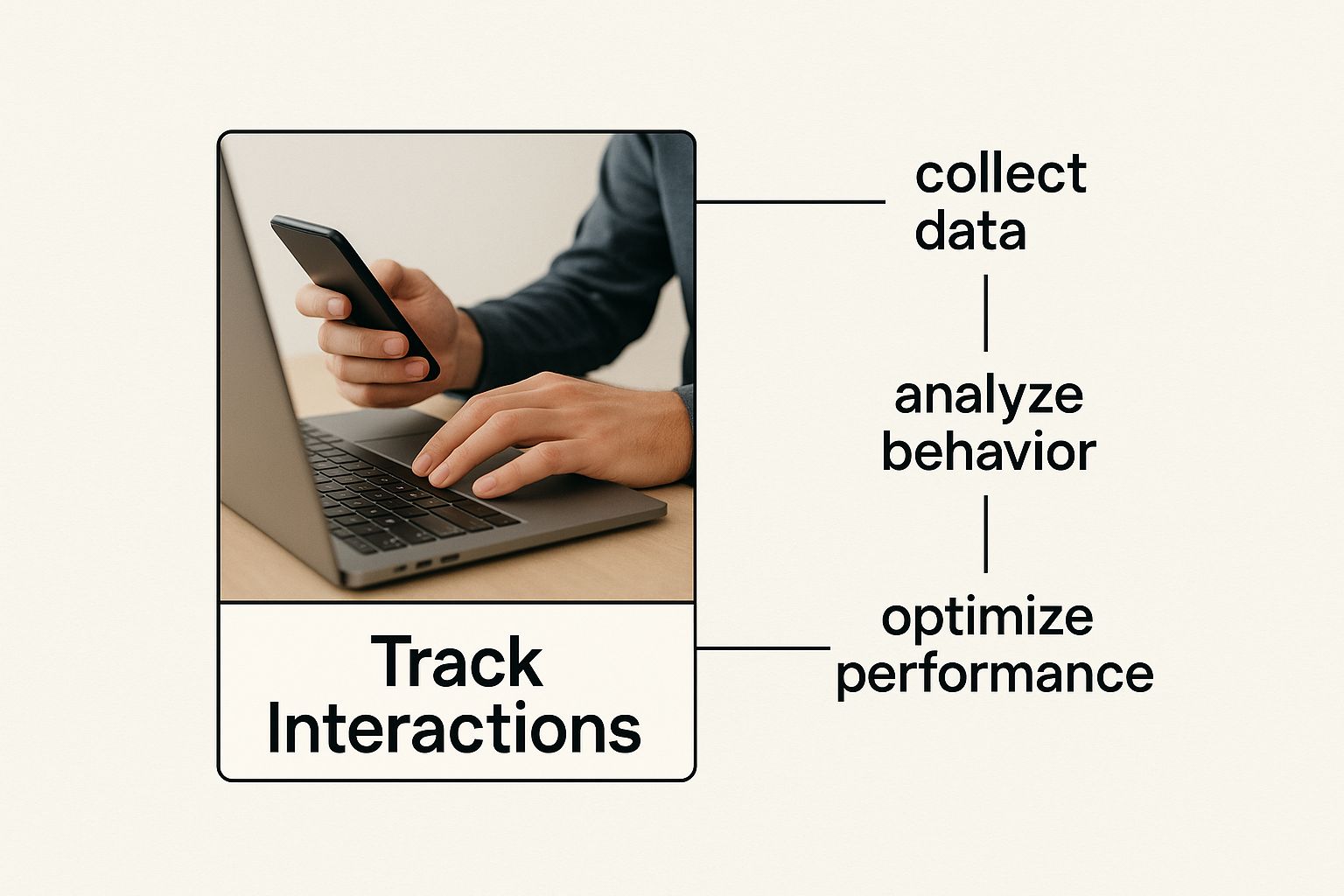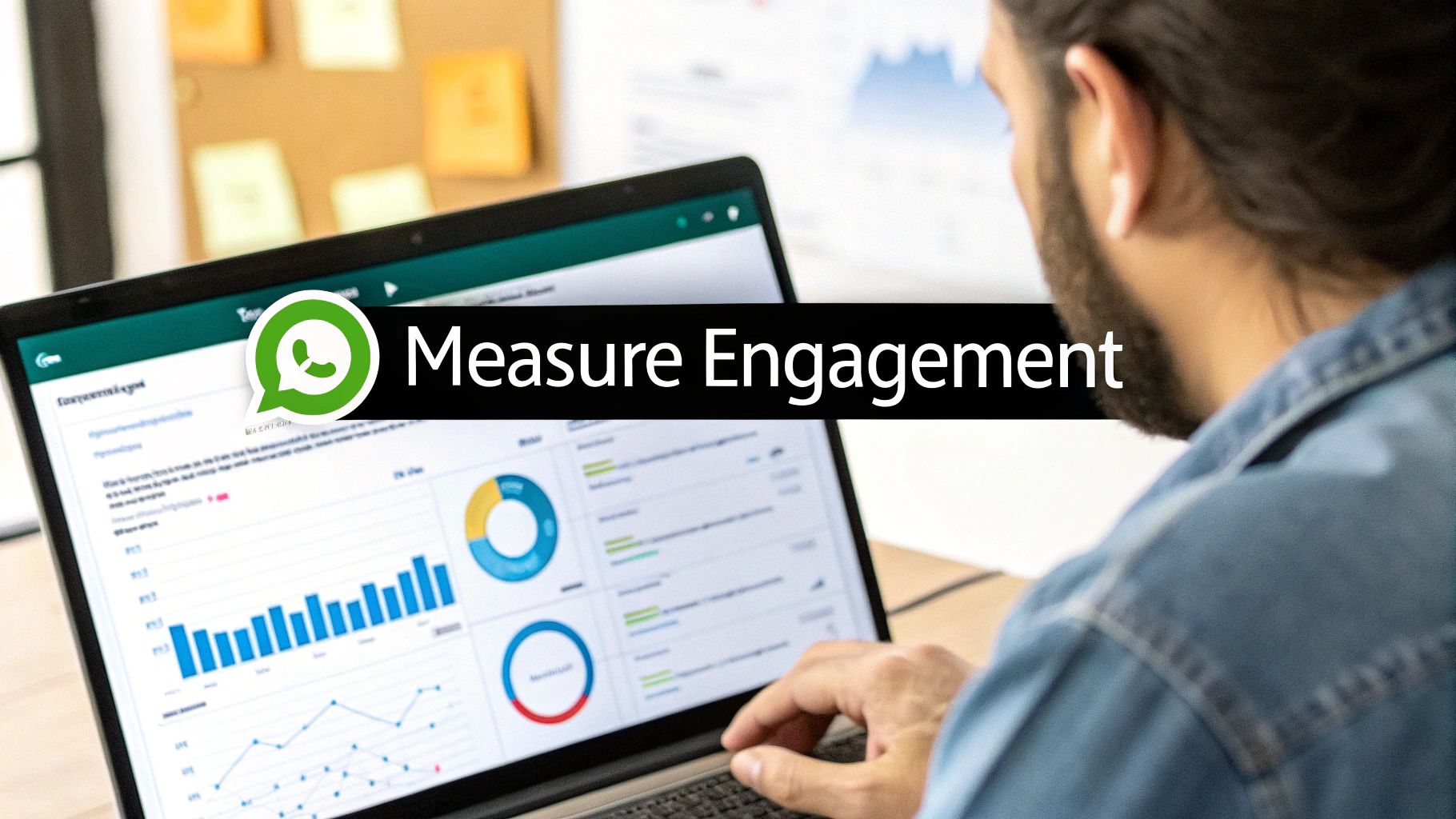Are you staring at your Shopify dashboard, feeling like you're flying blind? You see the opens and clicks piling up, but you can't connect them to what really matters: your bottom line. To truly understand how to measure customer engagement, you need to look past surface-level numbers and dig into actionable data—metrics like purchase frequency and customer lifetime value (LTV).
From our experience with over 500 Shopify stores, this is a common struggle. In this guide, we'll show you exactly how to move beyond vanity metrics and build a system that links every marketing action to a tangible business outcome. You'll learn the four pillars of engagement, the tools you need, and how to turn your insights directly into revenue.
Moving Beyond Vanity Metrics to Real Engagement

A common mistake we see is an over-reliance on "vanity metrics." These are the numbers that look impressive on a report but don't actually tell you if you're making money or building a loyal customer base.
Celebrating high email open rates or a surge in social media likes without asking the critical follow-up question, "So what?" is a recipe for wasted marketing spend. Did those likes turn into sales? Did those email opens lead to repeat customers? If you don't have an answer, you're not measuring engagement. You're just counting clicks.
The Shift to Meaningful Measurement
This guide cuts through that noise. We're going to show you exactly how to measure customer engagement with metrics that have a direct, undeniable impact on your revenue.
This isn't just a trend; it's a fundamental shift in how successful e-commerce brands operate. The global market for customer engagement solutions was valued at a staggering $23.45 billion in 2023 and is projected to more than double by 2030. This massive investment proves how critical genuine engagement has become for slashing customer churn and driving real growth. The key is to distinguish between metrics that feel good and metrics that do good for your business.
Vanity Metrics vs. Actionable Engagement Metrics
Focusing on actionable metrics gives you a clear, honest picture of your business's health.
The strategy that consistently delivers the best results for our clients is shifting conversations to more personal, high-intent channels. We lean on platforms like WhatsApp, which boasts 98% open rates, to gather the kind of rich, meaningful data you just can't pull from a standard email campaign.
In this guide, we’ll move from theory to a practical system you can put into action right away. You'll learn how to use powerful tools to get a true picture of how customers are interacting with your brand, transforming raw data into your most valuable asset.
The Four Pillars of E-Commerce Engagement
To truly understand customer engagement, you have to look beyond a single, isolated number. After helping countless Shopify stores grow, we've learned that the genuine customer connection that actually drives profit is built on four distinct pillars.
Thinking about engagement this way gives you the complete picture. You can stop guessing if your marketing is working and start making data-backed decisions that move the needle. Let's break down each pillar.
Pillar 1: Behavioral Engagement
This is all about what customers do on your website or app. Think of it as their digital body language. It tells you if they’re just window shopping or genuinely interested.
Here are the key things to watch:
- Session Duration: How long are people sticking around? Longer sessions on product pages are a fantastic signal of high interest.
- Pages Per Session: Are they clicking around to different pages? This shows they're exploring your brand, not just hitting a page and bouncing.
- Feature Adoption: Are customers using tools you’ve built, like wishlists or product review filters? When they use these, it’s a strong sign of a shopper who is seriously considering a purchase.
We've seen so many brands get obsessed with traffic. But a store with 1,000 highly engaged visitors who spend five minutes exploring will always outperform a store with 10,000 visitors who leave in 30 seconds.
Pillar 2: Conversational Engagement
This pillar measures the active, two-way dialogue between you and your customers. One-way communication is dead. Real engagement happens in conversation, especially on personal channels like WhatsApp.
Here, we're tracking:
- Reply Rates to Campaigns: When you send a WhatsApp offer, how many people write back? A reply isn't a passive click; it's a high-intent conversation starter.
- Inbound Message Volume: Are customers reaching out on their own to ask questions? This is a goldmine of feedback and a clear sign they trust your brand.
A common mistake we see is brands treating WhatsApp just like email, blasting out promotions. The real magic comes from starting a conversation. We’ve seen clients hit a 30%+ reply rate on interactive campaigns like quizzes, which then leads directly to sales.
To dive deeper, check out our guide on the most important customer engagement metrics you should be tracking.
Pillar 3: Transactional Engagement
This is where engagement puts money in the bank. Transactional metrics tell you not just if customers are buying, but how they're buying. It's the financial pulse of your customer relationships.
Focus on these core numbers:
- Average Order Value (AOV): How much do customers spend in one go? Engaged customers who trust you are far more likely to add that extra item to their cart.
- Repeat Purchase Rate: What percentage of your customers come back for a second or third time? This is one of the most powerful indicators of brand health.
Pillar 4: Loyalty Engagement
This pillar looks at the long-term health of your customer base and their willingness to advocate for you. These metrics predict future growth.
Key loyalty indicators include:
- Customer Lifetime Value (LTV): What's the total amount a customer is likely to spend with you? A rising LTV is the ultimate proof your engagement strategy is working.
- Net Promoter Score (NPS): On a scale of 0-10, how likely are your customers to recommend your brand? This simple question turns your happiest customers into a volunteer marketing army.
When you combine data from all four pillars, you get a complete, holistic view of what truly matters.

These pillars don't exist in a vacuum. A great conversation on WhatsApp (Pillar 2) can directly lead to a higher repeat purchase rate (Pillar 3) and, ultimately, a much better LTV (Pillar 4).
Building Your Engagement Measurement Toolkit

Let’s be honest: data is just noise until you have the right tools to make sense of it. To get a real handle on customer engagement, you need a tech stack that tells the full story.
The good news is you’re probably already sitting on a goldmine of information. Your Shopify dashboard and Google Analytics are brimming with valuable behavioral and transactional data. The trick is to go beyond surface-level metrics and dig into repeat purchase rates, customer cohort behavior, and time between orders. But that's only one piece of the puzzle.
Weaving in Conversational Data with Kanal
This is where a tool like Kanal, built on the official WhatsApp Business Platform, becomes indispensable. It bridges the gap between what a customer does on your site and what they say in a private message. Suddenly, you have a 360-degree view that website analytics alone can't provide.
This integrated approach is essential. Research shows 80.4% of enterprises credit cloud-based platforms for modernizing their infrastructure, allowing them to capture real-time data from chat and social media. You can discover more on how cloud solutions are shaping customer engagement.
When everything is connected, you can finally see cause and effect. You'll know exactly when a customer who ditched their cart finally clicks "buy" after a friendly WhatsApp nudge.
After working with over 500 Shopify stores, we've seen a clear pattern: the brands that grow the fastest unify their data. A common mistake is keeping website analytics and conversational data in separate silos. When you connect them, you unlock powerful new insights.
Creating That Unified Customer View
With Kanal, you can set up tracking that builds a complete timeline of your customer's journey. This dashboard shows how you can track revenue and orders generated directly from your WhatsApp campaigns—no guesswork involved.

This isn't about counting vanity metrics. It's about attributing real dollars to specific conversations. You can see precisely which messages are hitting the mark, letting you fine-tune your strategy with confidence.
Your toolkit should empower you to track key interactions like these:
- Campaign Responses: Go beyond open rates and measure actual reply rates and conversions for specific WhatsApp broadcasts.
- Cart Recovery Interactions: See exactly how many abandoned carts are rescued through your automated WhatsApp flows.
- Post-Purchase Feedback: Collect responses from satisfaction surveys sent via WhatsApp. This data is crucial for understanding how to measure customer satisfaction on a deeper level.
By combining these different data streams, you stop just collecting numbers. You start building a rich, actionable profile for every single customer.
Using AI to Predict and Personalize Engagement
Once you’ve got your core metrics dialed in, you can stop just reacting to what your customers did and start anticipating what they'll do next. This is where Artificial Intelligence (AI) can completely change how you approach customer engagement.
From our work with over 500 Shopify stores, we know the brands that pull away from the pack are the ones who shift from reactive measurement to predictive engagement. They use AI to forecast a customer's next move, unlocking a level of personalization that feels like a one-on-one service.
From Reactive Tracking to Predictive Action
Let’s take a classic e-commerce headache: cart abandonment. The old-school method is a generic "You left something behind!" email. It's a sledgehammer when you need a scalpel.
AI is your scalpel. Instead of a one-size-fits-all message, AI-powered tools like those built into Kanal can analyze customer data on the fly to trigger incredibly specific WhatsApp flows.
Here’s what that actually looks like:
- The High-Value Cart: A customer has a cart worth over $200. The AI can automatically send a message with a small, exclusive discount or free shipping.
- The Loyal Customer: A repeat buyer abandons their cart. The AI recognizes their purchase history and can send something personal, like, "Hey Alex, saw you were checking out the new running shoes. Let me know if you have any questions about sizing!"
- The New Visitor: For a first-timer, the AI might send a message highlighting your easy return policy or pointing to stellar customer reviews to build trust.
This isn’t just about being creative; it’s about getting results. A recent marketing survey showed that AI-driven personalization can lift conversion rates by up to 15%. That's a real, measurable impact that comes from speaking to the individual, not the crowd.
The strategy that consistently delivers the biggest wins for our clients is using AI to analyze conversational data. We can automatically detect customer sentiment—are they happy, frustrated, or curious? This lets us route conversations and shape responses in a way that dramatically improves their experience.
Getting Started with AI-Powered Engagement
Moving to an AI-first model sounds intimidating, but it's more straightforward than you might think. The first step is to connect your data sources. An integrated platform like Kanal, an official Meta Business Partner, handles this automatically, syncing your Shopify store data with your WhatsApp conversations.
Once you have that unified customer view, you can start building simple yet powerful AI-driven rules. You don't need a PhD in data science. You just need to know your customers and pinpoint those critical moments where a personal touch can make all the difference.
Turning Your Engagement Insights Into Revenue
So you have all this great engagement data. What now? Measuring is just step one. We've seen hundreds of stores collect fantastic insights and then let them gather digital dust. The real magic happens when you put that data to work.
It’s time to move from theory to action by building a simple, repeatable system: Measure > Analyze > Act > Repeat.
Creating Your Data-Driven Playbooks
Think of your key engagement metrics as signals. When a signal flashes—like a drop in your repeat purchase rate—it’s your cue to deploy a specific, pre-planned response.
For instance, if you see repeat purchases are down, it tells you customers aren't coming back. This is the perfect moment for a targeted WhatsApp win-back campaign. Forget the generic email blast. You can send something personal and immediate that actually gets seen.
WhatsApp Win-Back Template (For customers who haven't purchased in 90 days):
"Hey [Customer Name]! We've missed you at [Your Brand Name]. We just dropped a new collection we think you'll love. As a thank you for being one of our early customers, here’s 15% off your next order: [Discount Code]. Let us know if you have any questions!"
This approach isn't just about pushing a sale; it's about starting a conversation. It's direct, personal, and uses the incredible 98% open rates of WhatsApp to re-engage a customer who has gone quiet.
Responding to Conversational Signals
What if your sales are solid, but nobody is talking back to you? If customers aren't replying to your WhatsApp campaigns, that’s a loud and clear sign your messages are falling flat.
A tactic that consistently delivers for our clients is making the messages more interactive. Don't just broadcast an offer. Ask a question or run a quick poll.
- For a new product launch: "Hey VIPs! We're launching a new product next week. Would you rather see it in 'Ocean Blue' or 'Sunset Orange'? Your vote decides!"
- For gathering feedback: "Hi [Customer Name], thanks for your recent order! On a scale of 1-5, how would you rate your experience? Your feedback helps us get better."
These simple conversational starters build a community and make your customers feel like they're part of the brand. This is the heart of an effective engagement strategy and a key way to increase shopper retention.
Engagement Signals and Corresponding WhatsApp Actions
This table breaks down how you can translate raw data into a concrete WhatsApp marketing playbook. Think of it as your cheat sheet for turning insights into action.
By following a map like this, you're no longer just guessing. You're making strategic moves based on real customer behavior. To go even further, learn how to create a customer journey map that weaves these data-driven actions into every touchpoint.
Common Engagement Measurement Mistakes to Avoid
Knowing what not to do is just as important as knowing what you should be doing. After working directly with over 500 Shopify stores, we've seen the same handful of mistakes trip up even the sharpest brands.
The most common trap? Focusing on channel-specific metrics instead of customer-centric ones. A high email open rate feels good, but it tells you very little about a customer's long-term value. You have to shift your perspective to metrics that follow the customer's entire journey.
Another classic error is failing to segment your audience. Your most loyal VIPs behave completely differently than a first-time visitor. Lumping them together in your analysis will hide the most valuable insights and stop you from personalizing your outreach.
Inconsistent Tracking and Ignoring the Data
A massive—and totally avoidable—problem is inconsistent tracking across different platforms. If your website analytics, email platform, and WhatsApp data are all living in separate silos, you'll never get a true 360-degree view of your customer. This fragmented picture makes it impossible to know which touchpoints are actually driving conversions.
One of the biggest mistakes we see is brands that meticulously collect data but then do absolutely nothing with it. Your data isn't a report card to be filed away; it's a real-time roadmap telling you exactly where to go next.
And that brings us to the final, most damaging mistake: simply not acting on the data you collect. Every metric you track should have a purpose and a corresponding action plan. When you see a drop in a key metric, it should be an immediate trigger for a pre-planned response. To see how this works in practice, check out our guide on how to set up marketing automation that reacts to customer behavior in real time.
Answering Your Top Questions
We talk to e-commerce brands all the time, and a few key questions about measuring customer engagement always come up. Let’s tackle some of the most common ones we hear.
What's the One Metric That Matters Most for Engagement?
While it can shift depending on your business, we’ve found that Customer Lifetime Value (LTV) is the real north star. Honestly, it's the truest measure of a healthy, growing brand.
LTV rolls up everything that matters—how often people buy, how much they spend, and how long they stick around. It’s a single, powerful number that captures the long-term value you're building. When you see your LTV consistently climbing, it’s a sure sign you’re creating lasting engagement.
How Often Should I Look at These Metrics?
Great question. It's easy to get lost in the data, so we recommend a two-speed approach.
Weekly Check-in: Keep a close eye on your "frontline" metrics like your conversion rate and Average Order Value (AOV). A weekly glance is perfect for spotting any sudden drops or spikes that you can act on immediately.
Monthly or Quarterly Strategy Review: For deeper metrics like LTV and repeat purchase rates, a monthly or quarterly review provides enough data to see real trends emerge, helping you make smarter, big-picture decisions instead of reacting to daily noise.
Can I Do This Without Shelling Out for Expensive Tools?
Absolutely. You can get a surprisingly long way with the free tools you likely already have. Google Analytics and your native Shopify analytics are packed with behavioral and transactional data right out of the box.
But when you’re ready to get serious about conversational engagement on WhatsApp and automate personalized messages that convert, a dedicated tool is a game-changer. Investing in an official WhatsApp Business Platform provider like Kanal pays for itself by delivering a much higher ROI on your marketing spend and the deep insights you can't get otherwise.
Ready to Turn These Insights Into Revenue?
Now that you know how to measure customer engagement, it's time to put these strategies into action. The most successful brands are building deeper relationships with their customers on the channels they use every day.
- Focus on actionable metrics: Shift from vanity stats to LTV and repeat purchase rate.
- Unify your data: Combine website behavior with conversational insights for a 360-degree customer view.
- Act on your insights: Use data to trigger automated, personalized WhatsApp campaigns that drive sales.
Ready to build your own high-converting flows? Install Kanal on your Shopify store today or schedule a demo to see how we can help you turn conversations into customers.



